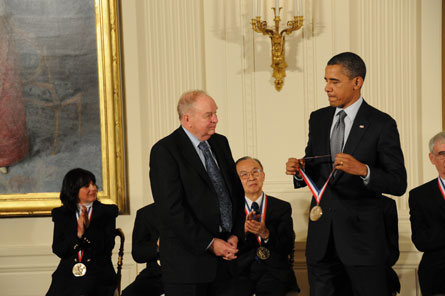Honeywell safety guru Don Bateman has been acknowledged by President Barack Obama for his widely adopted avionics innovations - but is not resting on his laurels
Don Bateman, hailed as the creator of the now ubiquitous enhanced ground proximity warning system (EGPWS), reached what some would call the pinnacle of any career in November.
Among a group of very distinguished guests at the White House, Bateman accepted the world's thanks for his life's work in safety in the form of the National Medal of Technology and Innovation, presented by none other than the US Commander in Chief, President Barack Obama.
The medal is awarded annually for "outstanding contributions to America's economic, environmental and social well-being" and is considered the highest honour the country can bestow on a citizen for "achievements related to technological progress", according to officials.
 |
|---|
| © Ryan K Morris Barack Obama presents Don Bateman with his National Medal of Technology and Innovation |
Those who know Bateman, inventor and co-inventor of more than 50 US and 90 foreign patents, will tell you the rub with political royalty did not go to his head - Bateman is working just as hard, if not harder, today than before the award, and he is just as pragmatic.
"Incidents are happening every day, and we can see the weaknesses. That's what we remain focused on," he says. By "we", he is referring to the small group of engineers - "all mavericks, that's what we need" - who work for him at Honeywell's flight safety systems and technology group in Redmond, Washington. Bateman's official title is corporate fellow and chief engineer-technologist.
While Bateman's office is best known for developing safety tools such as EGPWS, wind sheer warning systems and, more recently, the runway awareness and advisory system and stable approach monitor, the group is always looking to leverage existing products to improve safety.
Included in this is research into predicting potential wake turbulence encounters, a critical element for a next-generation air transportation system that boosts capacity by intelligently cutting separation distances.
"It's the rules of Isaac Newton: to keep something up on the air, you have to deflect air down," Bateman says of the predictable physics of the matter. The addition of precision GPS as part of automatic dependent surveillance-broadcast (ADS-B "In") systems in the near future will allow for navigation displays that show wake turbulence warning areas linked to traffic alert and collision avoidance systems targets, he says.
Loss of control, stall and unusual attitude recovery are other areas Bateman says he is "interested in", and areas he feels will be forcibly improved by regulations in the wake of Air France Flight 447, the Airbus A330 that crashed off the coast of Brazil on 1 June 2009 killing all 216 on board.
Although the cause of the crash has yet to be officially determined by the French government, recovered cockpit voice and data recorders revealed the crew was confused by sensory inputs. The data shows the pilots pancaked the aircraft into the ocean all the way down from cruise altitude, despite no obvious mechanical malfunctions other than the initial pitot probe icing issues that caused the flight computers to disable the autopilot and put the aircraft in "alternate" control law with no built-in envelope protection.
"[The industry] continues to improve interface between the autopilot and manual flight," says Bateman, a private pilot with more than 2,200h of flight time. "It's easy to get distracted though, and pilots only have seconds to get things straight. Somehow we need to keep the pilot in the loop. To hit him with lights and a long list of failures - that's a lot going on."
"Engineers tend to be arrogant and think we have the perfect answer," he says of designers of modern avionics and fly-by-wire systems, including himself. "We don't."
He notes that human factors in technology and training will be a key element in the solution to the complex problems introduced by increasing levels of automation, problems both Boeing and Airbus are working on as well as avionics manufacturers such as Honeywell. "I used to sneer at human factors," says Bateman. "But I don't any more."
Source: Flight International



















